Happy All-Hallow’s Month! In anticipation of Halloween — which, let’s face it, we’ve been anticipating since last Halloween — Daily Grindhouse will again be offering daily celebrations of horror movies here on our site. This October’s theme is horror sequels — the good, the bad, the really bad, and the unfairly unappreciated. We’re calling it SCREAMQUELS!
And if you like this feature, please check us out on Patreon for unique reads and deep dives! Just $3 a month gets you everything! All treats, no tricks.
There are many decent films that have had the misfortune to follow up masterpieces. Whether or not sequels should be made to some movies, or franchises born from certain pieces of incredible singular art, is a whole ‘nother debate. But in the case where a truly landmark film is made that is a classic (maybe not instantly, but eventually), often the size of its accomplishment make it impossible for any subsequent tale to measure up. This sets up that sequel for failure—if nothing could match that unique work of genius, then any further entries are operating from an inherently losing position and any gains will be diminished due to deserving accolades of the original.
Could an equally amazing film be made as a sequel to 1986’s THE FLY? Certainly—Cronenberg’s own film was a remake following a trio of films with varying degrees of successful storytelling. While it’s hard to see how another moment of confluence could match elegant writing with potent metaphors alongside pitch perfect casting and astounding performances in tandem with groundbreaking special effects, as THE FLY 1986 really had all of these components coming together in just the right way at just the right time, there is still fertile ground for further innovations in f/x, layered script dealing with biology and technology and identity, delivered with a bold artistic vision in the instruments of tremendous actors. So, while it is technically possible, it is certainly improbable that any sequel could’ve matched Cronenberg’s work. 1989’s THE FLY II, directed by Chris Walas from a script by mick Garris, Jim Wheat & Ken Wheat, and Frank Darabont, does not measure up to the gauntlet thrown by its predecessor, but still finds new ways in which to shine and even an occasional moment where it improves upon the 1986 version.
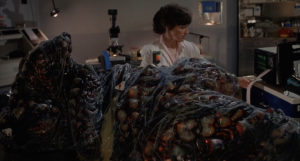
THE FLY II concerns the offspring of Seth Brundle (Jeff Goldblum) and Veronia Quaife (Geena Davis) and the legacy of Brundle’s experiments in teleportation and genetic splicing which lives on, literally within the blood of their newborn. The film begins auspiciously, and infamously, with the utterly unique arrival of young Martin Brundle into the world.
https://vimeo.com/manage/videos/627761884
(Sidenote: You’d be surprised how little had to be changed to make those two scenes match up visually and aurally)
Martin is now, ostensibly, the property of Bartok Industries, overseen by Anton Bartok (Lee Richardson) who has taken possession of Seth Brundle’s remaining tech, schematics, and information—though there are key components missing to truly unlock the potential of teleportation via Brundle’s pods. And thanks to his father’s unique genetics, Martin has a chromosomal abnormality which finds him aging at an advanced rate. His intelligence is far beyond genius levels, much to the chagrin of the scientists assigned to monitor him (Ann Marie Lee and Frank C. Turner) who seem to loathe this child with every fiber of their being. Bartok wants Martin to see the CEO as a second father, while also starting to weave through a motif about magic that ultimately leads nowhere. Still, Martin is a scamp who soon displays a penchant for invention and a restlessness with the confines of his life inside of the bowels of Bartok Industries.

1989 loved supergenius characters who wore the stupidest of helmets.
Eventually, Martin starts to roaming around the corporate compound at night and befriends a lovely dog in the part of the film that you remember best. Seriously, this plot thread not only pays off brilliantly in terms of story but also is the number one thing that everyone remembers the most clearly from this film, being emotionally wrecked over it. Martin’s new friend is actually a lab animal meant to be used in telepod experiments, only Bartok’s crew still doesn’t have a handle on the tech so the dog comes back wrong and breaks Martin’s tiny, rapidly maturing heart.
But then it’s his fifth birthday, and now Martin is played by Eric Stoltz in his most famous role as someone named Marty…errr….a boy with a genetic disorder that dramatically alters his appearance…errr…the kid who continues to bristle under the resentful eyes of security and scientists at Bartok while the evil industrialist himself starts to scheme to get their progeny to revamp Brundlefly’s work on the telepods.

Martin accepts the challenge and is rewarded with an awkward meet-cute with Beth (Daphne Zuniga, whom producer Mel Brooks recommended after working with her in SPACEBALLS). She’s practicing fly-fishing (groan) as she has yet to be taken seriously by the company. They have some nice moments, Martin hideously deforms her desk cactus into an abomination against God himself, and sparks are flying. Which leads to a montage straight out of a romcom that is truly tin-eared; set to k.d. lang’s cover of Roger Miller’s “Lock, Stock and Teardrops”, it’s an ungainly awkward combination of the duo dancing, practicing fishing, working on the telepods, and it eschews any real characterization or natural chemistry.
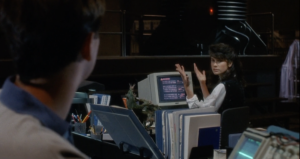
At once unfair and unavoidable, the comparison here to Cronenberg’s FLY is that Davis and Goldblum (and even John Getz, to a lesser degree) had moments where their care for each other and their real chemistry was allowed to bloom, which grounded the insane sci-fi horror in human emotions and also made actions at the end that much more impactful as people are invested in the internal lives of these characters. Instead, Walas and company simply have Martin react to the first woman he finds that’s not sticking him with needles, they apparently don’t really talk about much outside of modern alternative country and different computer commands to enter, and yet viewers are expected to care and to believe that sparks are a-flying between the two.
Unfortunately, those same sparks come to a very sudden halt when The Thing You Remember From This Movie comes back. Despite assurances from Bartok, the dog wasn’t peacefully euthanized following the botched experiment but has been living in agony at the bottom of a dark concrete pit covered in hay where it eats from a plate of slop every so often. That seems pretty Brutalist and low-tech for a leader in innovation like Bartok, but it does the trick of making Martin no longer trust his captors and delivers a heartbreaking moment as the The Boy Who Would Be Fly takes it upon himself to release his former furry friend from the pain of existence. It’s a legitimately moving scene that’s notable because it gives insight into Martin’s character, it’ a relatable moment of loss that bonds the audience with the lead, and it also spurs further action as now Martin fully distrusts Bartok and the others. Way to go, screenwriters Mick Garris, Jim Wheat & Ken Wheat, and Frank Darabont! And while the dog puppet isn’t great, the sound f/x added to its mournful eyes and Stoltz impressive acting sell the whole thing and now you just want to watch all of Bartok Industries burn to the ground.

This is compounded when it turns out that Bartok is spying on Martin, even recording the time he had sex with Beth. Which, gross on Bartok but also – gross on you, THE FLY II. Martin is five-years-old. Yeah, he looks like the guy from SOME KIND OF WONDERFUL and he’s a supergenius, but there’s still lots of emotional and psychological maturing needed to go from 5 to knocking boots with the Melrose Place mainstay. It underlines that this Bartok may not be on the level, while also giving head of security Scorby (played by Garry Chalk) some screentime to be gross and insulting to Beth and Martin. The Fly Prince of Bartok is beginning to physically change as well, not just aging but with pronounced physiological changes in his bone structure and more (he’s becoming Martinfly), and so he and Beth hightail it out of there and go to find the only person with answers, Stathis Borans (John Getz). Getz is also the only person staying on from the 1986’s THE FLY except for some archival footage of Goldblum. Not even the telepods are the same ones as they were scrapped as soon as filming shut down on that film.
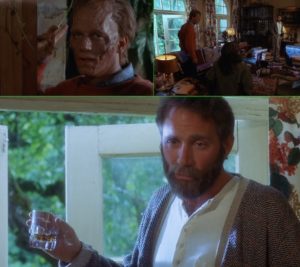
Getz makes an interesting actor choice to sound like a liquored-up Gabby Hayes, but then I can’t tell you how someone should react after having his hand and foot dissolved in ManFly vomit. Martin realizes there is no cure unless he enters the telepods with another person and sequences the pods to remove the mutant genes and replace them with human ones, but it would effectively transmutate and/or kill that other person.
Before entering into some cocoon, Martin gives off some of that patented Brundle supremacist talk that he’s feeling better than he ever has before…despite the fact he literally can’t move his feet, raise his voice, and he just removed the lens on one of his eyeballs. The BrundleFly turn into thinking he’s an evolutionary superman made sense in the 1986 film, Goldblum had time to enjoy the perks of Fly life before mutating and then his mind warped. Here it feels like an attempt to make it okay that Martin is clearly about to become a literal monster and kill some folks. But we, the audience, are already on board with him killing these pricks. They let his mom die early on, lied to him, videotaped him having sex with a cast member of SPACEBALLS, and we still demand our pound of flesh in vengeance for that damn dog. It would have been better to have Martin worry about what he’s becoming; that he’s tried to control so much and now he has no control over anything…except the one thing he knows he can trust, which is Beth. Instead, he freaks her out so she calls Bartok who rounds up the duo and we prepare for the final act.
Martin locked the telepods with a prompt that no one can solve lest they destroy the whole process. Beth has no answers for them, but their interrogation for her is cut short as MartinFly emerges from his cocoon and starts taking fools out. He kills (off screen and not that gruesomely) the two scientists that have been giving him shit 24-by-7, but then the (uzi packing?) security team becomes his next targets. And that’s when we get a GLORIOUSLY gory kill of some poor schmuck who probably thought his biggest danger as security personnel for a tech company was Steve Jobs stealing another hard drive from Xerox (never forget!). Instead…he gets this:
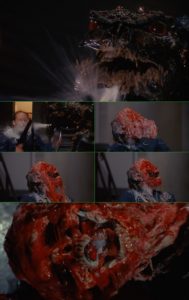
So THAT’S where that GIF is from!
It’s gnarly. The effect is so well done and grisly but made even more potent by the fact that audiences can see that the stunt double is still breathing and writhing a bit, with some nice sound design work to add in gurgling and such. It is a badass gore sequence that will have everyone suddenly sit up with alarm and possible delight. We also get our first look at the new model of ManFly and…eh….it’s not bad. It just looks like a Skeksis from DARK CRYSTAL dressed up like Baxter Stockman from the Teenage Mutant Ninja Turtles cartoon. It’s hard to say if they should have leaned more into the creature aspect, the human aspect, or the hybrid one, but it feels like an amalgam of shortcomings that’s not gooey or gross enough to haunt people (or evoke emotional responses) like BrundleFly’s final forms. Next he breaks in to the telepod room and attacks the security there. First there’s another gnarly bit of gore with one gun-wielding rent-a-cop.
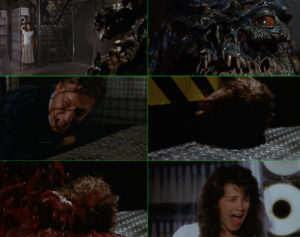
But that sequence is paced really poorly and is an unintentional version of the slow crushing gag from AUSTIN POWERS. Still, my man’s head pops like a casaba melon and it really harshes the buzz between Beth and MartinFly. The next to go is Scorby who just gets his back broken and then a really poorly-made dummy is thrown across the room. The dude was THE heavy—not the ultimate bad guy, but the one that should be ripped apart or some sort of ironic punishment like a bug zapper or something. I don’t know. I just know that he dies the same way as Stephen Furst does in SILENT RAGE, and that’s never a good thing.
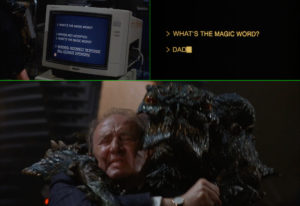
MartinFly then grabs his captor/stand-in father figure and hauls Bartok into the telepods in hopes that the gene-switching will work. There’s a nice bit of unintentional comedy where Martin tries to communicate to Beth to press a button to initiate the sequence. It should play out as Beth reluctant because she may be losing the man she loves while Martin is clinging to hope to retain any shred of humanity, but it plays like a couple doing really poorly at charades at a party. “What? Push? No. Push?” YES! IT’S PUSH! JUST PUSH IT! What is the real downside you’re risking here?
Beth does crack the unspoken code and initiates the launch. The doors of the lab open as the remainder of the security personnel and others file in to the room in time to see the telepod open up and reveal…Zuckuss from EMPIRE STRIKES BACK? Tiny Hedorah from GODZILLA VS. THE SMOG MONSTER? It’s Bartok, now all monster-ed up, while Martin is covered in gooey viscera that Beth helps pick off him. There’s also a nice bit that is so subtle it’s easy to miss, but Stoltz has to step OUT of the Bartok monster in order to better appear human on screen. So you have a character that is moving out of the villain’s body like he’s taking off a pair of galoshes. It’s terrific. I don’t buy that Beth and Martin will ever be physically intimate again after this, but the outcome is still terrific.
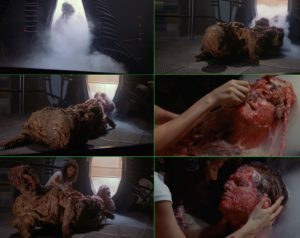
And then, to show that all four writers paid attention in English class, the audience is treated to the dark O. Henry-esque ending for Bartok, who now finds himself as the occupant of the concrete well with hay floor and eater of slop. Why was that even initially built into the structure? But still, it feels good to watch the supervillain get the ultimate comeuppance and also very specifically tie it to the traumatic death of that poor dog that will stay with audiences long after the credits roll.
THE FLY II has some effective moments that make it far more accomplished and impactful than it had any right to be. It will always live in the shadow of Cronenberg’s 1986 film, but it doesn’t deserve any sort of easy dismissal or ire. Mostly, it seems forgotten, but it would be a fun title to happen across and watch with surprise with the face melting (and the heartbreaking – that poor dog!). THE FLY is a property that feels like it should be remade every 30 years or so; not only for an updating of effects abilities, but also scientific issues (nuclear power in cold war, mercantile reasons for shipping, perhaps genetic rewriting in the latest) and social topics that can all tie in with new ways of scaring the hell out of viewers. The basic premise is all about a small oversight, one minor slip-up, leading to an avalanche of terror and a body count in a story that is fairly ridiculous on the outside but ends up becoming incredibly emotionally engaging in its telling. Hopefully somewhere a talented auteur is getting ready to bring their vision of insectile mutations to the big screen.

Tags: Ann Marie Lee, Bartok, Body Horror, Brooksfilms, Bugs, Canada, chris walas, Chris Walas Inc, Christopher Young, Curse Of The Fly (1965), Daphne Zuniga, Daryl Alexander, David Cronenberg, Eric Stoltz, F/X, Frank Darabont, Frank Turner, Garry Chalk, Geena Davis, George Langelaan, gore, Harley Cross, Jeff Goldblum, Jim Wheat, Jon Berg, Jon Getz, Ken Wheat, Lee Richardson, Matthew Moore, Mel Brooks, Mick Garris, Return Of The Fly (1959), Robin Vidgeon, Rose Marie McSherry, Saffron Henderson, Sean Barton, Sequels, Tess Felix, The Fly (1958), The Fly (1986), The Fly 2, The Fly II, William S. Taylor

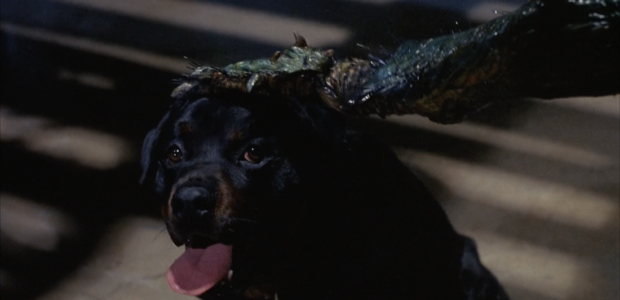

No Comments